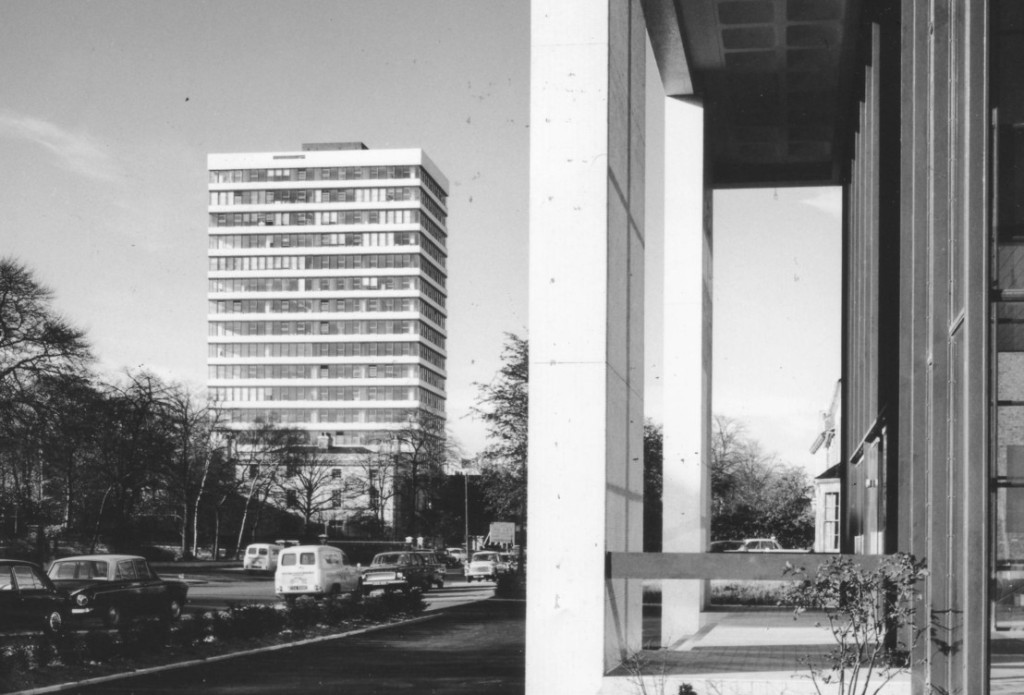Alan Clawley looks back at Birmingham’s innovative office blocks.
We take the tall modern office block so much for granted now that it’s hard to imagine what a big impact the first ones would have had on the workers who occupied them and the people who first saw them. In Birmingham, architect John Madin led the way. He would have seen photos and may have visited Lever House in New York which was opened in 1952.
Madin’s own opportunity to build a tall office came in 1955 when he was asked to design a new headquarters for the Chamber of Commerce in Harborne Road. He persuaded the Chamber to add an extra eight storey office block which could be let out to tenants to help pay for the more lavishly appointed HQ building. It was Edgbaston’s first tall post-war office and it had the honour of being officially opened by the Duke of Edinburgh in June 1961.
The business community must have liked what they saw. A succession of office blocks followed: Auchinleck House (Seymour Harris, 1962); Lyndon House (Madin, 1964); The Rotunda (Roberts, 1965); Hagley House/Cobalt Square (Madin, 1965); Quayside Tower (Madin, 1965); Post & Mail (Madin, 1966); McLaren House (Bonham, 1972); Alpha Tower (Seifert, 1973); Tricorn House (Kaye-Firmin, 1974); Metropolitan House/1 Hagley Road (Madin, 1974); the NatWest Tower (Madin, 1974); 54 Hagley Road (Madin, 1978) and Five Ways Tower (PSA, 1979).
In 1958 Madin began to design the 16-storey Lyndon House in the Calthorpe Commercial Zone on the Hagley Road, a pioneering high-rise ‘business park’ designed to attract businesses and their office workers out of what was then a dingy, cramped and war-damaged city centre. Lyndon House was opened in 1962. In the meantime he designed a second block, the 16-storey Hagley House (now named Cobalt Square) on the opposite site of Hagley Road. The official opening by the Lord Mayor, Councillor Frank Price, in 1965 was filmed by the BBC and featured in the Six Men documentary. In the presence of the London property developer and the press the Mayor said about the building, “It’s designed in the nicest possible way on an accessible site in a wonderful area and a more wonderful city”.
In one of many meetings that I had with Madin he recalled how on their first day’s work at Hagley House the female workers from the old city-centre buildings had worn drab jerseys and thick skirts but in their second day, after they had seen how warm and light their new offices were, they came in light summer dresses. The contrast between the stone-built, compartmentalised offices in town and the new towers with their open-plan floors, panoramic windows and views out must have been exhilarating. The landscape in which the towers were set completed the transformation of their working environment.
Madin went on to design more office towers and its a measure of their success that they remain popular and well regarded today. He considered the 18-storey Metropolitan House at 1 Hagley Road his best, although it has now been internally adapted by its current owner to provide luxury apartments. This could indicate that there is less need for these types of office buildings now given the changing nature of business and the growing use of wireless digital communications.
Pioneers often pay the price for being first in the field because those coming after them can learn from their mistakes. The Chamber of Commerce now considers Madin’s 56-year-old buildings to be outdated. They want to pull them down and build a bigger and taller office block that will bring in more rents to make up for the loss of public subsidy to the organisation. The Chamber’s proposal will not please those of us who would like the buildings to be kept to remind us of a critical moment in Birmingham’s history – the building of the first speculative modern office block.
